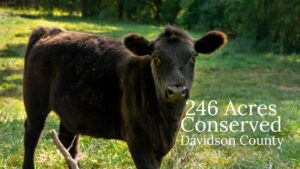
 by Crystal Cockman
by Crystal Cockman
September 27, 2016
One interesting and beautiful plant you may have commonly seen before along a river or creek, sometimes in great number, is spotted jewelweed (Impatiens capensis). You may be more familiar with another of it’s names – touch-me-not. It is also called common jewelweed, orange jewelweed, or orange balsam.
Spotted jewelweed is a plant that grows predominantly in wetlands and can grow up to five feet tall. It grows in the shade, often in dense stands. It has trumpet-shaped orange flowers with red spots and the flowers are approximately an inch long, with a three-lobed corolla, and a hooked conical spur at the back of the flower. They have succulent translucent stems. When the leaves are underwater they look silvery and when wet they glisten, which may be why they got the name jewelweed.
Jewelweed is an annual, which means it only lives for one year. It must come back from the seeds the next year. The seeds grow in pods, which expand in size, building up pressure until they explode when touched. This is why they are also called touch-me-nots. It is also an explanation for the genus name, impatiens, referring to being impatient. It blooms from July to October.
The flowers are dichogamous, which means the male and female parts mature at different times, to avoid self-pollination. The male parts are ready first, with the anthers ready for pollen release for only a 24-hour period, then the anthers drop and the female stigma is exposed. The stigma can receive pollen for only a short time as well, an average of four hours or so. Seeds are more long than they are wide, and each seed pod has between 3 and 5 seeds in it.
Jewelweed is known for its skin healing properties. The leaves and sap is used to relieve the itch of poison oak, ivy, and other plant induced skin rashes, as well as other types of dermatitis. It works by counteracting the chemicals in other plants that cause the rashes. Salves and poultices are also used as folk remedies for other ailments, such as bruises and sprains, as well. It is also used for treating athlete’s foot.
Jewelweed is pollinated by a variety of species. Hummingbirds, especially the ruby-throated hummingbird, choose jewelweed as a favorite nectar source. Bees and butterflies also pollinate spotted jewelweed. Keep an eye out for this bright orange flower next time you’re near a wetland or creek. They are pretty to behold and their interesting exploding seedpods make for a great way to engage children in the unique features of nature.